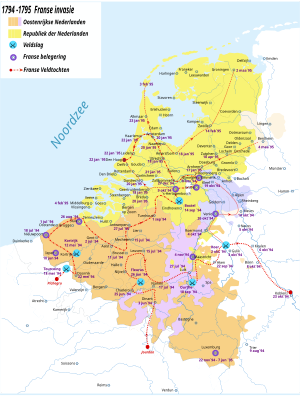
Back حملة الفلاندرز Arabic Campaña de Flandes Spanish Kampanye militer Flandria ID Campagna delle Fiandre Italian 플랑드르 전역 Korean Franse veldtocht in de Nederlanden Dutch Фландрська кампанія Ukrainian 第一次反法同盟低地戰場 Chinese
| Low Countries theatre of the War of the First Coalition Flanders campaign | |||||||
|---|---|---|---|---|---|---|---|
| Part of the War of the First Coalition | |||||||
 The French conquest of the Low Countries from May 1794 until June 1795 | |||||||
| |||||||
| Belligerents | |||||||
|
|
| ||||||
| Commanders and leaders | |||||||
| |||||||
The Low Countries theatre of the War of the First Coalition, in British historiography better known as the Flanders campaign, was a series of campaigns in the Low Countries conducted from 20 April 1792 to 7 June 1795 during the first years of the War of the First Coalition. As the French Revolution radicalised, the revolutionary National Convention and its predecessors broke the Catholic Church's power (1790), abolished the monarchy (1792) and even executed the deposed king Louis XVI of France (1793), vying to spread the Revolution beyond the new French Republic's borders, by violent means if necessary. The First Coalition, an alliance of reactionary states representing the Ancien Régime in Central and Western Europe – Habsburg Austria (including the Southern Netherlands), Prussia, Great Britain, the Dutch Republic (the Northern Netherlands), Hanover and Hesse-Kassel – mobilised military forces along all the French frontiers, threatening to invade Revolutionary France and violently restore the monarchy. The subsequent combat operations along the French borders with the Low Countries and Germany became the primary theatre of the War of the First Coalition until March 1796, when Napoleon took over French command on the Italian front.[a]
The April–June 1792 French incursions into the Austrian Netherlands were a disaster, eventually leading frustrated radical revolutionaries to depose the king in August. An unexpected French success in the Battle of Jemappes in November 1792 was followed by a major Coalition victory at Neerwinden in March 1793. After this initial stage, the largest of these forces assembled on the Franco-Flemish border. In this theatre a combined army of Anglo-Hanoverian, Dutch, Hessian, Imperial Austrian and (south of the river Sambre) Prussian troops faced the republican Armée du Nord, and (further to the south) two smaller forces, the Armée des Ardennes and the Armée de la Moselle. The Allies enjoyed several early victories, but were unable to advance beyond the French border fortresses. Coalition forces were eventually forced to withdraw by a series of French counter-offensives, and the May 1794 Austrian decision to redeploy any troops in Poland.
The Allies established a new front in the south of the Netherlands and Germany, but with failing supplies and the Prussians pulling out, they were forced to continue their retreat through the arduous winter of 1794/5. The Austrians pulled back to the lower Rhine and the British to Hanover from where they were eventually evacuated. The victorious French were aided in their conquest by Patriots from the Northern and Southern Netherlands, who had previously been forced to flee to France after their own revolutions in the north in 1787 and in the south in 1789/91 had failed. These Patriots now returned under French banners as "Batavians" and "Belgians" to 'liberate' their countries. The republican armies pushed on to Amsterdam and early in 1795 replaced the Dutch Republic with a client state, the Batavian Republic, whilst the Austrian Netherlands and the Prince-Bishopric of Liège were annexed by the French Republic.
Prussia and Hesse-Kassel would recognise the French victory and territorial gains with the Peace of Basel (1795). Austria would not acknowledge the loss of the Southern Netherlands until the 1797 Treaty of Leoben and later the Treaty of Campo Formio. The Dutch stadtholder William V, Prince of Orange, who had fled to England, also initially refused to recognise the Batavian Republic, and in the Kew Letters ordered all Dutch colonies to temporarily accept British authority instead. Not until the 1801 Oranienstein Letters would he recognise the Batavian Republic, and his son William Frederick accept the Principality of Nassau-Orange-Fulda as compensation for the loss of the hereditary stadtholderate.
- ^ Fremont-Barnes 2006, p. 488.
Cite error: There are <ref group=lower-alpha> tags or {{efn}} templates on this page, but the references will not show without a {{reflist|group=lower-alpha}} template or {{notelist}} template (see the help page).
© MMXXIII Rich X Search. We shall prevail. All rights reserved. Rich X Search